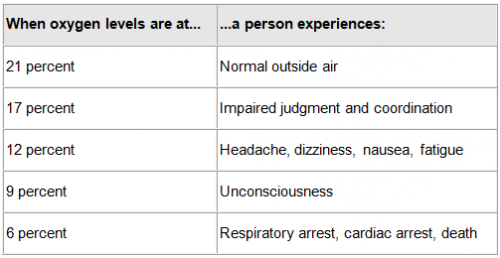Smoke inhalation is the most common cause of death in house fires
When a fire occurs in a home, occupants can quickly be overcome by smoke and unable to reach nearby exits. Planning and practice can help you survive.
According to the National Fire Protection Association (NFPA), most fire deaths are the result of smoke inhalation rather than burns. NFPA notes that every 20 seconds somewhere in the United States a fire department is responding to a fire. Once a minute, a fire is occurring in a home or other building that most likely has occupants. Historically, some very famous and deadly fires have occurred in crowded, public settings such as night clubs and theaters, claiming hundreds of victims. Fortunately, that is not the norm. Fire experts find that most fires today occur in a person’s home or vehicle and generally involve one or two victims.
Why is it so difficult for people to escape a fire in their own home even though they know the layout well and it likely is small enough that multiple escape routes are close at hand? One reason cited is that the smoke may be so thick and dense that occupants are disoriented. In order to burn, fire requires oxygen and consumes much of the available oxygen individuals need to breathe and remain conscious. This can happen so quickly that occupants are overcome and unable to reach easily accessible exits. The NFPA’s chart below illustrates what occurs to a person at various oxygen levels. Notice that once oxygen levels drop to half the normal amount, movement toward exits becomes difficult or impossible:

The NFPA explains another problem is the synthetic materials used so commonly in home construction and furnishings today. When burning, they produce extremely dangerous substances that are released into the air. These toxic gases may replace the oxygen and be inhaled by victims struggling to find their way out of the burning structure. Carbon monoxide is one well known substance that can be very deadly even in small amounts. When plastics such as PVC pipes burn, the hydrogen cyanide released can interfere with cellular respiration. Another product, phosgene, is formed when household products, including those containing vinyl, burn. Low levels of phosgene may result in itchy eyes and cause a sore throat while higher levels can cause death.
Symptoms of smoke inhalation range from coughing and vomiting to nausea, sleepiness and confusion. If you notice a fire victim has difficulty breathing, singed nostril hair, and burns to their nose, mouth or face, seek immediate medical attention for them. A fully-developed indoor fire can reach or exceed temperatures of 1100 degrees Fahrenheit. Even one breath of this very hot air can be lethal. Inhaling superheated gases can burn your respiratory tract whether or not the gases present are toxic. Those who suffer burns are at even greater risk as burn victims often have injuries to their lungs from inhaling hot smoke. Over 50 percent of people with severe burns and smoke inhalation die.
What can you do today to better prepare yourself and family members to survive a home fire? The American Red Cross (ARC) stresses the importance of planning and preparing your family for a number of different types of disasters. Visit their Home Fire page to download a Home Fire Escape Plan worksheet and a Home Fire Safety Checklist. Use and review these tools with family members as recommended. The ARC and affiliated organizations have created Talking About Disaster: Guide for Standard Messages. Pages 23-32 of this document offer excellent suggestions, tips, facts and fiction about home fires. You will find guidelines for smoke alarm location, routine testing, and battery replacement. As fires can happen at any hour of the day, fire experts recommend conducting a family fire drill at least twice a year; once during daylight and again at night. You might even practice getting out of the house while blindfolded to simulate how dense the smoke could be. Family members should all know to get out first, and then call for help from a neighbor’s house or cell phone once they have reached your family’s designated meeting place. As time is of the essence during a fire, it is never a good idea to delay exiting a burning building to call the fire department or search for a cell phone. Once outside, do not re-enter a burning home to search for pets or family members.
After the fire is over and you are allowed by fire officials to re-enter your home, Michigan State University Extension has resources to assist with deciding what food is safe to consume and what should be discarded. You can contact your local Extension office or search online for experts at MSU and other Extension universities throughout the country to find answers you need to keep your family safe.
Start today by holding a family meeting, then working together to make and practice your family disaster plan.



 Print
Print Email
Email